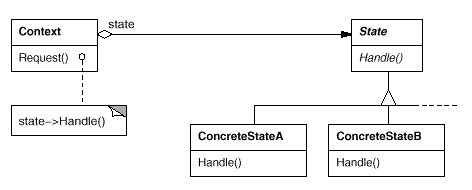- Intent: Allow an object to alter its behavior when its internal state changes. The object will appear to change its class
Structure §

Image from: Gamma, Helm, Johnson, and Vissides
Applicability §
- An object’s behavior depends on its state and it must change its behavior at run time depending on that state.
- Operations have large, multipart conditional statements that depend on the object’s state. (often represented as an enum).
Consequences §
- It localizes state-specific behavior and partition behavior for different classes.
- New states can easily be added
- Increases the number of classes depending on the number of states.
- Makes state transitions explicit
- State objects can be shared
Implementation §
Who defines State Transitions? §
- If the criteria are fixed, it can be done on the context.
- It is more flexible to let state subclasses to specify their successor state. (introduces dependencies between classes)
Creating and Destroying State Objects §
- Create state objects only when they’re needed and destroy them afterwards (states aren’t known at run time and contexts change frequently)
- Create states ahead of time and never destroy them (state changes occur rapidly and storage isn’t an issue)
